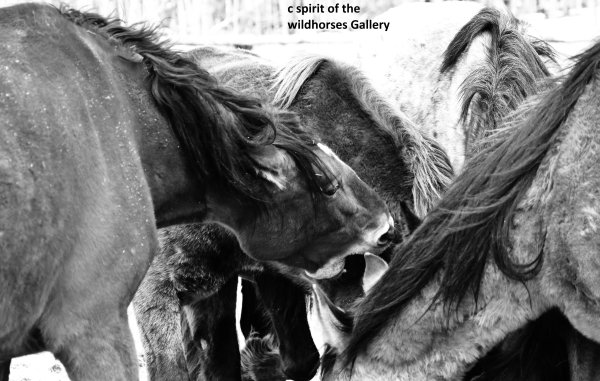About the wildhorses
Why are these photographs so special? There are a number of other populations of free-ranging horses found allover the world. Most populations of wild horses consist of „feral animals“ what means that they are domesticated animals that have returned to the wild. Such horses are wild in the sense that they are generally free to roam as they please. They can form various social organizations, reproduce, and forage for their own food and water, and survive or succumb to disease, weather and predators. But many of these free-ranging populations are exposed to some form of interference by people: fertility control, feeding, round-ups, adoption programs etc. The wildhorses of the Chilcot ìn mountains -where are all pictures from- are among the few wild horse populations that are entirely unmanaged: They are not subject to any kind of interference! Also it is very difficult to observe them. Most of the time they spend deep in the forest or in areas where you have to hike for several hours and where no car and nearly no ATV can get. And you cant get very close to them. Kiki observes the horses for a long time now and knows who belongs to which family band. She has now one band where she is allowed to come a bit closer than 300m. (see the "black and white collection" on this page) A DNA testing proofed that the Chilcot`in horses directly belong to the spanish mustangs BUT: that they also have yakutic blood and many more interesting things...

Learn more about the wildhorses and the Xeni Gwent`in from the Nemiah Valley
(Thank you to David Williams. Please visit the www.fonv.ca website)
There are estimated to be between 800 and 1,000 wild or free-roaming horses in the Chilcotin. As many as 42% of these can be found within the ?Elegesi Qayus Wild Horse Preserve declared by the Xeni Gwet'in First Nations Government in 2002. The core Brittany Triangle area, lying between the Chilko and Taseko Rivers, contains about 200 truly wild, genetically distinct horses. The latter have experienced dramatic environmental and fire related environmental changes over the past ten years, yet continue to thrive and maintain their numbers, thus demonstrating considerable biological resiliency.
The Brittany and Nemiah Valley horses have achieved iconic status and have become the focus of intense global interest because of speculation as to their genetic and historic origins. They are the subjects of ongoing genetic analysis and cultural and ecological research by FONV (Friends of Nemiah Valley), independent researchers, and graduate students.
Since the wild horse preserve declaration, they have been protected by a Xeni Gwet'in Wild Horse Ranger funded by FONV. In 2007 the Supreme Court of B.C. found that the Tsilhqot'in people had an aboriginal right to manage them for their own use.
The province of British Columbia still refuses to recognize them as a species with a right to remain on the land, even though historical evidence is clear that they long preceded European settlement. FONV will continue to argue for their recognition as legitimate wildlife.
Since 2002, Friends of the Nemaiah Valley have been able to fund the first and only Wild Horse Ranger Patrol program in Canada.
We knew that the declaration of the “?Elegesi Qiyus Wild Horse Preserve” would draw attention to the iconic nature of the horse. For most this would be positive, but some might disagree. After all, government policies have not been kind to the wild horses of the Chilcotin in the past. Prior to 1946, thousands of wild horses were shot in the Chilcotin by government sanctioned bounty hunters profiting at the expense of these animals, receiving $3.00/mare and $5.00/stallion. Even until the mid ‘60s they were rounded up for horsemeat. There is no government agency that provides any protection for these animals today.
The obvious solution is to have rangers who will provide surveillance and protection of the horses and other wild animals of the preserve. The Xeni Gwet’in First Nations Government and BC Parks have a joint management agreement which provides for rangers within Ts’il?os Park and Nunsti Parks, but this leaves the rest of the preserve unpatrolled.
FONV decided that initially we would set out to raise funds to fund a ranger half time. We applied to the Vancouver Foundation and received a startup grant. When we combined this with private donations targeted to this program we had enough to begin.